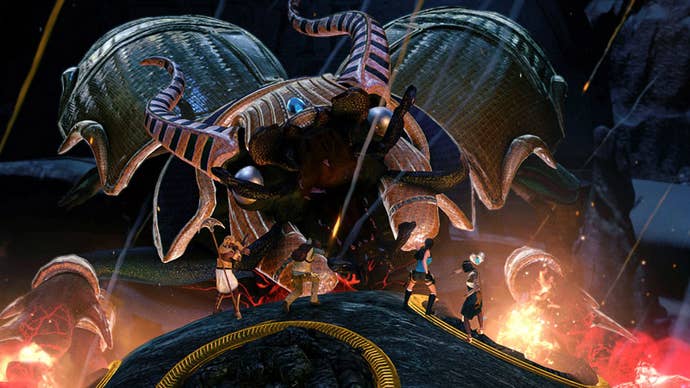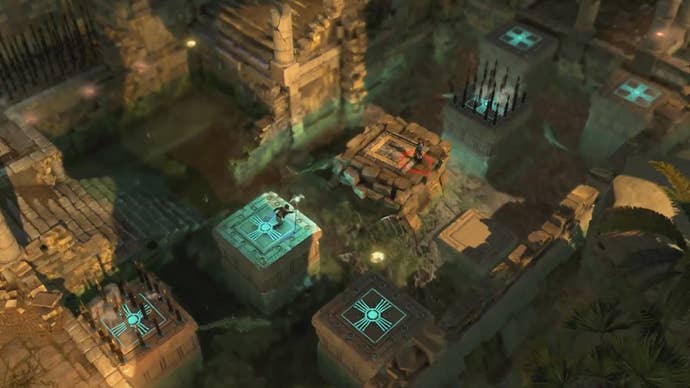Lara Croft and the Temple of Osiris Xbox One Review: Pulp Fiction
This Tomb Raider spin-off feels breezy and superficial, and that may be its greatest strength.
This article first appeared on USgamer, a partner publication of VG247. Some content, such as this article, has been migrated to VG247 for posterity after USgamer's closure - but it has not been edited or further vetted by the VG247 team.
When Raiders of the Lost Ark debuted way back in 1981, it felt nothing short of revelatory. Here was a film created in the spirit of the old black-and-white serial shorts of the 1940s, the pulpy comic books of the pre-Code era, yet produced with the healthy budget and cutting-edge technical know-how of the finest of Hollywood.
The intersection of lowbrow action and high-end spectacle could have resulted in disaster, but the men behind Indiana Jones' first adventure — George Lucas and Steven Spielberg — were at the height of their game. Their movie captured the freewheeling, globe-spanning fun of the old serials while simultaneously elevating the form to proper cinema. Freed of the no-budget morass of the olden days, Raiders turned the corny air-punches of something like The Phantom into rollicking, brilliantly choreographed sequences that made clever use of props, turning Nazi military vehicles into mobile action sets and even deadly weapons in and of themselves. With the increased budget Paramount invested into Raiders came a higher grade of acting and effects, too. Lucas and Spielberg could afford to hire talented actors like Harrison Ford, Karen Allen, and John Rhys-Davies to sell audiences on all the visual spectacle by grounding it with an emotional core.

But Raiders' studio backing came at a cost: Despite transmuting the Saturday afternoon serial into respectable cinema, an important essence of those pulpy B-films was sacrificed: The fact that they were serials. Unlike the heroes of old Republic shorts, Indy only appeared in four films. His other adventures, though hinted at in broad strokes within the movies, only exist through apocryphal ancillary works: Books, comics, a television series, some video games. The effort required to create a film of Raiders' calibre — with a polished script, a millionaire cast and crew, and increasingly elaborate cinematography and visual effects — limits their frequency as a matter of necessity.
It's fitting, then (or at least, inevitable) that the Tomb Raider series, which draws so much inspiration from Raiders of the Lost Ark, has ultimately gone the same way. While Tomb Raider's original creators Core Design were perfectly content to embrace the serial spirit by pumping out annual releases of the series, the current studio responsible for the adventures of Lara Croft, Crystal Dynamics, aims to make each Tomb Raider title more of an event. Those rapid annual iterations have given way to tentpole releases; we've seen only three new Tomb Raider titles since 2006, when Crystal Dynamics took over.
Perhaps more to the point, every Tomb Raider release now aspires to be an event, chronicling only the most important events in Lara Croft's life. There's no room for a throwaway episode like Tomb Raider III, not when the games are this expensive to make. (Like many third party titles these days, the upcoming Rise of the Tomb Raider appears to be getting a helping hand in return for console exclusivity.) Tomb Raider may have pulp origins, but it has blockbuster aspirations.
That's what makes the series' new spinoff, Lara Croft and the Temple of Osiris, so appealing. Like its predecessor (Lara Croft and the Guardian of Light), Osiris casts the hard-edged tomb raider into a completely superfluous tale that plays like a simplified version of the old PlayStation titles. Gone is the immersive, behind-the-shoulder 3D camera, replaced instead by a completely fixed isometric camera. It looks a bit like Diablo, but it plays more like the isometric action games of 8-bit British microcomputers such as the ZX Spectrum.
Functionally, though, it's really Tomb Raider through and through: The game combines shooting and solving environmental puzzles with the same careful balance as the "real" Tomb Raider titles. Working your way to the next destination invariably involves throwing a great many levers, making impressive leaps, dashing to complete an objective before a timed trap resets, or maneuvering interactive objects to work as keys or hold down switches. Enemies appear as a sort of punctuation: Either flooding in to liven things up between puzzle sequences or, especially late in the game, livening up the puzzle sequences themselves.

It's not without its flaws, this game. The fixed perspective and the four-player single-screen cooperative design means everything in the game is teeny-tiny, and amidst all the busy details of the environments you'll often lose track of small enemies. The isometric view, unsurprisingly, creates a number of complications; it can be exceedingly difficult to judge enemy positions and projectiles, and evasion is made all the more challenging by Lara and company's inability to turn on a dime. Like most contemporary action game heroes, they sort of swing about when they turn, which can make delicate maneuvering on the tiny platforms that appear throughout the adventure fairly maddening. And of course simply lining up your jumps across platforms that rise to various heights is always an exercise in trial-and-error; veteran players will experience unhappy memories of games like Landstalker as they watch Lara plummet to her death despite the fact that you could totally swear you lined up that jump perfectly.
So yeah, the "are you kidding me?" factor gets pretty high at times, especially in the late game. Still, the penalties for death feel fairly light, especially if you play cooperatively — though the gentle checkpointing of co-op tends to be somewhat balanced out by how easily you can accidentally blow up your friends with bombs, especially if you equip accessories that increase the range of your explosives. And even though you'll come to moments where you die in rapid succession without it really feeling like your own fault, for the most part the game manages to be interesting enough that you forget your bitter feelings once you clear those sticking points.
The change in visual perspective isn't all bad, either. Besides allowing for co-operative play on one screen, it also changes the overall game design balance. While deeply rooted in the fundamentals of Tomb Raider, Osiris is able to toss a lot more action at players — skeleton warriors, giant scarab beetles, mournful lost souls and more attack in droves, overwhelming players with projectiles and lingering environmental hazards. Bosses fill the screen, generally requiring ingenuity rather than twitch reflexes to win. And Lara (and friends) move nimbly and can tote an entire arsenal's worth of weapons, from flamethrowers and grenade launchers to the inevitable twin Desert Eagles.

Still, by no means does Osiris settle for merely being an action game. The game's control scheme is testament to that: It reserves buttons for the exclusive purpose of tossing Lara's grappling hook or using a mystical staff that interacts with certain elements of the environment. One part twin-stick shooter, one part platformer, one part classic Tomb Raider, Osiris manages to bring a lot of disparate elements together into a single game. It can be a little bumpy at times, but on the whole it works pretty well.
And of course, the biggest difference here over classic Tomb Raider, besides the camera perspective, is the inclusion of cooperative play. Four-person play, to be precise, which sets it apart even from Guardian of Light (which topped out at two players). The action scales remarkably well; aside from a handful of optional bonus dungeons, you can complete the entirety of Osiris alone. Playing solo actually feels like a different experience to playing with others, and not just because other people get in the way and make things messy. There's an asymmetry about multiplayer, as only one player at a time can wield the all-important staff. As such, you have to approach many puzzles differently when other people join in, because skills aren't universal, and your tagalongs often need help keeping up with the leader.
What I like most about Lara Croft and the Temple of Osiris, though, is the way it calls back to the old-school Tomb Raider games in both substance and spirit. Lord knows those old adventures weren't perfect, but that was part of their pulp serial appeal. Osiris doesn't feel at all essential to Lara's long-term story, but rather like a simple episode in her career... and presumably an apocryphal one at that, given that it sees her teaming up with Egyptian gods in order to take part in the aftermath of the legend of Osiris' dismemberment, which is a bit out there even for this franchise. It's not great, but that's the charm of the thing.
VisualsDespite the tiny size and fixed perspective, Osiris features lots of effects... though sometimes the screen gets a bit crowded and hard to parse.
SoundSuitably atmospheric music is undermined by constant annoying chatter. The game scales according to the number of players, but not the audio — everyone keeps babbling even if you're solo.
InterfaceThe pulled-back camera angle allows for an explosion of action. The default controller scheme may seem odd, but it suits the gameplay.
Lasting AppealA decently lengthy adventure worth playing solo and with friends. And there's a ton of extra objectives and hidden treasures for those who covet such things.
ConclusionThe fact that Temple of Osiris features the classic, confident, adult version of Lara Croft rather than the newfangled, young, vulnerable version should tell you exactly what this game is aiming for: Simple escapism, a video game for gaming's sake. It's not the next chapter in the Tomb Raider saga, and it doesn't push any boundaries in narrative or game design. Instead, it's a fast-paced action puzzler, energetic and accessible; and while it does stumble in a few places, it manages to deliver the sort of lowbrow entertainment it promises — just the way a series borne of classic pulp serials should. Different enough to stand apart from core Tomb Raider titles, and inexpensive enough that its throwaway nature won't offend, Temple of Osiris sets its sights for a modest target and hits it with aplomb. There's something to be said for that.
